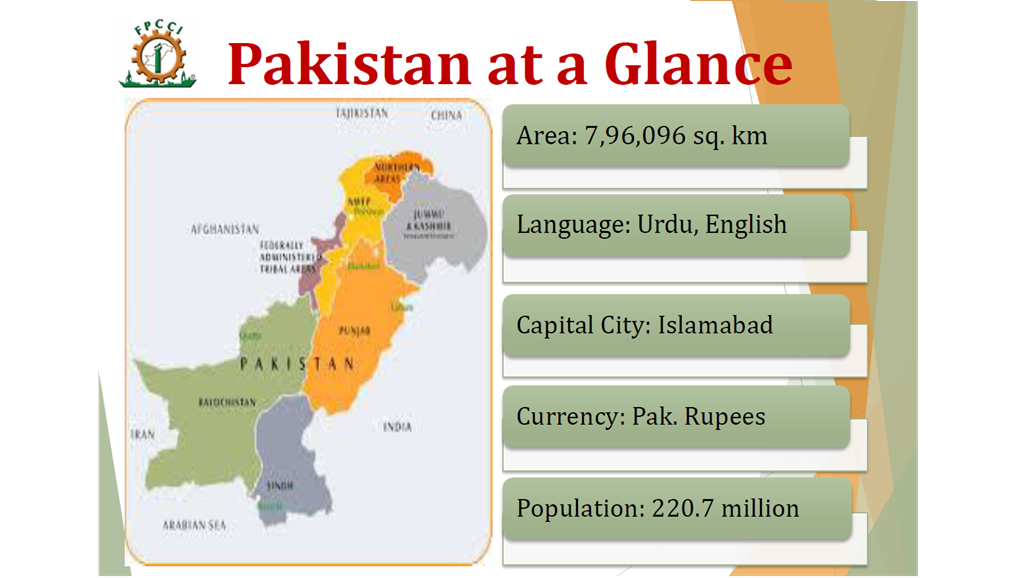Driving Economic Integration Across Asia-Pacific: A Conversation with Atif Ikram Sheikh
(1) Tell us about yourself and your experience working with international organizations. How long have you been associated with them?
As an entrepreneur, I started my career in a family business in 2000 and am currently leading Mujahid Group of Industries as chief executive, which operates in the fields of oil, ghee, construction, real estate, steel, etc. As a leader, I am serving as the president of the Federation of Pakistan Chambers of Commerce and Industry (FPCCI - an apex trade body representing the private sector).
Internationally, I am serving as the president of the ECO Chamber of Commerce and Industry (an alliance of 10 countries) and vice president of the Confederation of Asia Pacific Chamber of Commerce and Industry (an alliance of 27 countries). I am also a member of the board of directors of the Islamic Chamber of Commerce and Development, D-8 Chamber of Commerce and Industry, the Shanghai Cooperation Organization Business Council and the OIC Accreditation Council.
Previously, I have served as the president of Islamabad Chamber of Commerce & Industry, Haripur Chamber of Commerce and Industry, and Chairman of Pakistan Vanaspati Ghee Manufacturers Association.
Being a policy advocate, I am a member of the board of administrators for the Export Development Fund (EDF), the Economic Advisory Board of the Ministry of Finance, the board of directors of Pakistan Steel Mills Corporation, and the advisory council of Pakistan Standard & Quality Control Authority, among others.
In recognition of my services, several awards and honors have been conferred by the President and Prime Minister of Pakistan. Being a leading group, my industry has received various export awards and achievement awards from FPCCI and other organizations.
I am also a philanthropist and trustee of various organizations.
(2) How would you assess the current economic outlook of the Asia-Pacific region? What role can CACCI play in enhancing economic relations among member countries?
The Asia-Pacific region comprises a diverse group of countries encompassing highly industrialized countries, least developed countries, landlocked developing countries, and small islands that are at different stages of development. The region’s GDP is twice that of America, three times that of Europe, and eight times that of the Africa.
Over the past two decades, economic growth in the region has ranged between 6% and 8% driven by industrialization and international trade. According to projections from the Asian Development Bank and the International Monetary Fund, the region’s economic growth will be moderate and will stand in between 5.0% to 6.0% on average in 2025 and 2026.
Current geopolitical tensions in the Middle East and global financial crisis will least impact on this region, as Asia-Pacific economies have remained vibrant compared to other parts of the world. The region contributes around 60% of global GDP and relies heavily on intra-regional trade.
Thanks to abundant opportunities, favorable policies, and the low cost of doing business, the region attracts huge FDI from Europe and America. In addition to agriculture and industry, the tourism and hospitality sectors also contribute significantly in different countries.
Overall, the Asia-Pacific region is expected to lead global growth in the coming years, driven by technological advancement, structural transformation, innovation, high-tech industries, regional connectivity, energy transition, skilled human resources, and tourism potential. Instead of relying on other region, countries within the Asia-Pacific should enhance trade and economic relations within the region.
As a representative body of the private sector, CACCI plays a vital role in the economic development of the Asia-Pacific region by fostering trade, investment, and industrial cooperation among its member countries.
As a platform of chambers of commerce and industry of 27 countries, CACCI aims to reduce trade barriers, promote business linkages, and enhance regional economic integration - ultimately contributing to sustainable growth and prosperity in the region.
CACCI is a good platform for facilitating and promoting trade across the Asia-Pacific region. It should continue to actively serve as a trade bridge between low-income and developed economies in the region by organizing commercial activities, facilitating collaboration and dialogue among members, hosting business networking sessions, arranging trade delegations, and promoting the exchange of information. I have been associated with this organization for the last 14 years.
 (3) How does the business community perceive the future of Asia-Pacific countries in the coming decades?
(3) How does the business community perceive the future of Asia-Pacific countries in the coming decades?
The business community of the Asia-Pacific region is very much optimistic about the future of its countries as newly industrialized, emerging, export-oriented, and fastest growing economies are in this region. These economies are diverse in nature and play a crucial role in structural transformation and export and manufacturing led growth.
The region receives significant FDI in technology-driven industries, attracting 40% to 45% of global FDI, which has contributed significantly to its economic development. Cottage industries and SME sector also contributes significantly in countries like Singapore, Japan, Korea, Malaysia, Vietnam, Hong Kong etc. for economic growth and employment generation.
There is deeper economic integration among Asia-Pacific countries, as they are highly interdependent in terms of trade, investment, and the movement of capital and labor. Green industries, e-commerce, digitalization, fintech, high-tech industries, and digital assets etc. are main drivers of economic growth in the region.
Moreover, clean and renewable energy, agro-based industries, and service-oriented industries etc. has also scope because of technological advancement, a large consumer base, and the region’s export-oriented economies.
The government of the Asia-Pacific countries are also very supportive of creating a business-friendly environment to attract foreign investment and encourage regional investment. The advanced economies of the region should help the small and low income economies of the region in their growth and development.
(4) How can Asia-Pacific countries enhance trade relations with other regions, such as the European Union and the Americas?
Asia-Pacific countries have strong and significant trade relations with the European Union (EU) and the Americas region. According to the World Trade Map, the contribution of Asia-Pacific to EU trade is around 50%, and to the Americas, it is 60%. It is expected that after the imposition of tariffs by the U.S. on a reciprocal basis, exports from many Asian countries will be affected and may decline in the coming years.
The EU and U.S. have bilateral trade agreements with many Asian and Pacific countries that are playing a crucial role in facilitating trade, reducing barriers, and promoting economic integration. Textile, leather, machinery, automobiles, pharmaceutical goods, surgical items, mineral fuels, electronics goods, and agriculture products are the main exports from Asia- Pacific countries to European Countries and the Americas.
Small and underdeveloped economies of the Asia-Pacific region also enjoy different trade accords and preferential statuses with the EU and the U.S., such as Everything But Arms (EBA), Least Developed Countries (LDC) status, Generalised Scheme of Preference (GSP), and GSP+. However, these countries are facing supply chain, economy of scale and productivity related issues.
At present, there is need for multilateral trade negotiations between the Asia-Pacific and the EU and Americas to facilitate broader trade cooperation and promote economic integration. Moreover, trade promotion activities are also the need of the hour, including exchanges of delegations, participation in commercial activities, and the exchange of market information.
(5) What role do trade policies and agreements play in promoting trade within Asia-Pacific countries?
Trade agreements and trade policies play a crucial role in fostering economic integration, reducing trade costs, removing of trade barriers, improving competition, and ultimately enhancing trade and investment among countries. Within the region, there are several trade agreements, such as the Asia- Pacific Trade Agreement, the Regional Comprehensive Economic Partnership among ASEAN countries, the Trans-Pacific Partnership, the Pacific Island Countries Trade Agreement, the Indo-Indo-Pacific Economic Framework. These range from free trade agreements to region al economic partnerships.
These agreements facilitate trade through tariff reduction, increased flow of goods and services, simplification of customs procedures, removal of bottlenecks, and boosting economic growth and development among member countries. In addition, trade agreements also facilitate investment, which contributes to technology transfers, competition, innovation, diversification, and employment generation.
According to the World Trade Organization, the contribution of the Asia-Pacific region accounts for around 60% of the global total of preferential free trade agreements. In addition to multilateral trade agreements, bilateral trade agreements within the Asia-Pacific region are also very common and play a key role in enhancing trade both within and beyond the region. These agreements contribute to almost 55% of intra-regional trade among member countries.
Overall, trade agreements among regional countries are the need of the hour for driving trade and investment flows, facilitating cost efficiencies, and diversifying supply chains, including the use of specialized expertise and resources. They also permit countries to exhibit advanced technological capabilities, allowing businesses to access cutting-edge innovations and specialized production techniques.
We should work to ensure that the Asia-Pacific remains the world’s most dynamic and interconnected regional economy and continue working together to deliver a free, open, fair, non-discriminatory, transparent and predictable trade and investment environment.
 (6) As one of Pakistan’s leading business figures, how do you view the current state of intra-regional trade and investment within the Asia-Pacific?
(6) As one of Pakistan’s leading business figures, how do you view the current state of intra-regional trade and investment within the Asia-Pacific?
At present, some major economies are moving toward trading more with geopolitically closer partners, while others continue to deepen their international trade networks - both geographically and across the geopolitical spectrum. Asia-Pacific is now the world’s second-most integrated trade region, after the EU. Intra-regional trade in the Asia-Pacific is more significant than in other regions, accounting for more than 50%. Similarly, Australia has increased its trade with Asian countries to 50%.
The Asia-Pacific region has undergone a major transformation⸺from being solely the world’s production hub to becoming an important center for consumer demand, With remarkable and constantly evolving networks in trade, investment, and innovation, Asia has progressively positioned itself at the center of the global economy, driven by the rapid growth of manufacturing supply chains across borders.
Asia-Pacific comprises a diverse range of countries that are at different stages of development, indicating a growing trend of regional integration. Trade agreements and supply chains are becoming increasingly interconnected. The major trade routes in the region include the Maritime Silk Road, intra- Asia route, the Strait of Malacca, the Southeast Asia trade bloc, Pacific blocs, and the South Asian trade blocs. intra-Asian trade within these regions has surpassed trade with the EU and U.S. markets, indicating the strength and resilience of intra-Asian trade despite economic uncertainty and market turbulence.
There are strong ties among member countries, which have contributed significantly to enhancing intra-regional trade. Over the past decades, Asia-Pacific economies have continued their global presence primarily through investment in renewable energy, natural resources, and information technology.
Pakistan is located at a critical geostrategic position in South Asia and can connect South Asian countries with landlocked Central Asian countries. With a population of 2 billion, South Asia is becoming an economic powerhouse, and the formation of regional economic blocs has become a crucial route for economic growth. Moreover, Pakistan’s participation in massive bilateral projects like China-Pakistan Economic Corridor (CPEC) further enhances its position as a key trade hub in the region. For Pakistan, the benefits of trade within Asia- Pacific include access to large Asian market, a diversified supply chain, and an expanded customer base.

(7) What is your assessment of the business environment in Pakistan? What advice would you give to international investors regarding investment opportunities and the business climate in the country?
Pakistan is an emerging economy situated in South Asia, serving as a gateway to the energy-rich Central Asian states, the financially liquid Gulf states, and the economically advanced Far Eastern tigers. The conducive business environment in Pakistan offers huge investment opportunities in sectors such as corporate farming, leather, mining and quarrying, automobiles, tourism and hospitality, food processing, logistics, housing, construction, renewable energy, information technology etc.
Pakistan’s investment policy promotes a investor-friendly environment, by providing a level playing field, focusing on offering incentives, opening up the economy, and marketing its potential for foreign direct investment. Up to 100% foreign ownership and equity is allowed in all sectors, as the country has a market-oriented economy with a rapidly growing private sector. The high rate of return and low cost of doing business continue to attract foreign investors.
The Foreign Private Investment Promotion and Protection Act of1976 and the Protection of Economic Reforms Act of 1992 provide legal protection for foreign investment. Special Economic Zones (SEZs), particularly those under the China-Pakistan Economic Corridor (CPEC), offer incentives such as customs exemptions and tax holidays. Additionally, initiatives like the Special Investment Facilitation Council (SIFC) offer streamlined support and one-window services to ease market entry and business operations.
Overall, the macroeconomic environment in Pakistan is favorable for new investors, as all sectors of the economy are growing -reflecting an improving business climate. Pakistan’s exports are rising, and inflation is under control, both indicators of business stability and opportunity. Moreover, Pakistan’s imports are currently twice its exports, demonstrating the country’s interest in attracting new investments in both export oriented and import-substitution industries.
From the platform of FPCCI and CACCI, I would like to invite all countries and business leaders to visit Pakistan and get first-hand information about the business opportunities available.
(8) What key policy recommendations would you propose to accelerate economic development in the Asia-Pacific region, particularly in Pakistan?
he Asia-Pacific is a region of emerging and developing economies, where inclusive and sustainable growth is the need of the hour. In this context, promoting inclusive and green growth, enhancing trade and investment integration, building resilient economies, reforming financial institutions, and structural transformation should be the main agenda for economic growth and development in the Asia-Pacific region.
Moreover, many Asian countries are facing similar challenges - such as climate change, lack of innovation, food insecurity, weak human capital, inadequate infrastructure, etc. ⸺that need to be addressed collectively to achieve the Sustainable Development Goals.
Pakistan should also strengthen its trade and economic relations with Asia-Pacific countries, which would be mutually beneficial and could lead to significant economic and strategic advantages for both sides in terms of trade and investment. At present, Pakistan has trade pacts with Iran, Sri Lanka, China, Indonesia, and Malaysia.
While some of these agreements are favorable for Pakistan, others are less advantageous. Pakistan needs to revisit these pacts and develop broader strategic partnerships with Asia-Pacific countries, particularly given its geographic advantage as a connector between Asia and Europe.
Moreover, we should bring together the business communities of Pakistan and other Asian countries by organizing commercial activities aimed at enhancing trade and economic relations.




